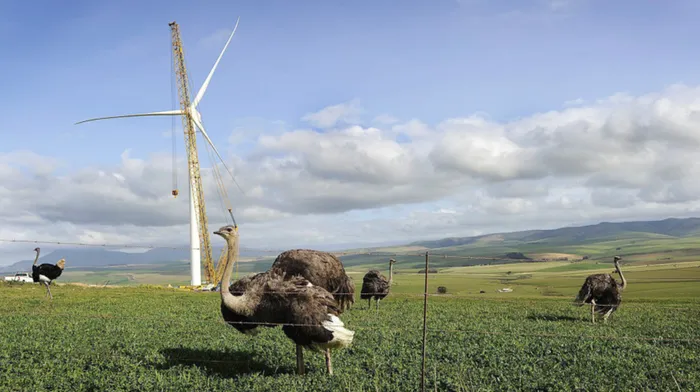Renewable energy puts wind up Eskom

Caledon 131007 Ostriches walk near the first completed wind turbine ouside Caledon. Photo by Michael Walker Caledon 131007 Ostriches walk near the first completed wind turbine ouside Caledon. Photo by Michael Walker
Melanie Gosling
Environment Writer
SOUTH Africa’s wind energy capacity has grown from just eight turbines in 2012 to 294 today – the result of a R55bn investment by the private sector, the SA Wind Energy Association (Sawea) said yesterday.
Speaking on Global Wind Day yesterday, Sawea chairman Johan van den Berg said it appeared likely that renewable energy could account for 40 percent of South Africa’s electricity generation by 2030.
“It looks as if it’s doable, and wind will make up a large part of that 40 percent.”
To date, 750MW of wind energy has been installed under the government’s Renewable Energy Independent Power Producer Procurement Programme. In addition to this amount, which is already feeding into the grid, the Department of Energy has approved in excess of 3 000MW of additional wind energy.
The industry has created 19 414 jobs over the last three years, of which 93.5 percent went to South Africans.
Van den Berg said the latest prices for wind energy were 62c a kilowatt hour, making it 40 percent cheaper than “new coal” – the cost of electricity generated by newly built coal-fired power stations. The construction costs of all local coal power stations were paid off many years ago, resulting in a relatively low price for electricity generated by these old power stations.
“No one knows what the price of electricity from Medupi will cost, but the last conservative estimate I heard was R1.05 a kilowatt hour.”
Renewable energy tariffs bid by the private sector have fallen between each round of bids submitted, with wind tariffs having fallen by more than 70 percent from the first round to the latest.
The Department of Energy stipulated that renewable energy companies had to invest a certain amount in the socio-economic development of residents who lived within a 50km radius of the energy plants. To date, this had resulted in a R7bn investment.
“That was a very far-sighted thing the department did. Everywhere I go, to international gatherings and conferences, people are very excited about the socio-economic aspect. I don’t think it’s happened anywhere else.”
Wind energy was used to avoid 117 hours of load shedding last year – equivalent to R800m – and saved Eskom R1.7bn in coal and diesel.
The Global Wind Energy Council said yesterday wind energy had become “fully mainstream”, was one of the fastest-growing sectors globally and had attracted $100bn investment in 2014.
Steve Sawyer, secretary general of the council, said there had been a growing move among many large companies to power their industries with wind.
“Climate change is happening faster than expected, but so is the transition to renewable energy. As businesses become aware of the falling costs, we are seeing a rapid change in investment patterns,” he said.